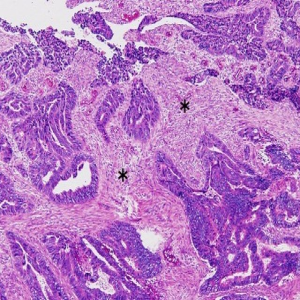Colorectal carcinoma in a tertiary hospital in North-western Nigeria: a histopathologic retrospective review

Accepted: 30 January 2023
All claims expressed in this article are solely those of the authors and do not necessarily represent those of their affiliated organizations, or those of the publisher, the editors and the reviewers. Any product that may be evaluated in this article or claim that may be made by its manufacturer is not guaranteed or endorsed by the publisher.
Authors
Colorectal Carcinoma (CRC) accounts for about 3.9% of all malignant lesions in human beings with several studies identifying it as the most common gastrointestinal malignancy. It was previously considered to be more common in developed nations of the world but recent studies have reported increasing trends in developing nations. The study was done on all cases of colorectal carcinomas diagnosed between 1st January 2001 and 31st December 2010 in the Department of Histopathology of a tertiary institution. The laboratory request forms and the duplicate copies of histology reports were retrieved for extraction of relevant clinical information like age, sex, anatomical sites of the lesions and clinical presentations. Histological diagnoses and grading were also extracted. Corresponding haematoxylin and eosin-stained slides were retrieved and evaluated. Special stains were carried out where necessary. The lesions were classified according to the World Health Organization (WHO) histological variants and tables and figures were used to illustrate the results. A total of 186 cases of colorectal carcinoma were diagnosed during the period, representing 3.9% of the total malignant tumors and 50.4% of the gastro-intestinal malignancies. One hundred and ten cases (59.1%) and 76 cases (40.9%) were in males and females respectively with a male:female ratio of 1.46:1. The age range was from 17-87 years with a mean of 42.8 years and peaked at 61-70 years. Site distribution showed rectosigmoid lesions accounted for 64.5%, caecum, ascending colon, transverse and descending colons accounted for 9.1%, 3.8% and 2.2% each respectively. Most of the cases were adenocarcinoma (71.0%), followed by mucinous carcinoma (23.7%) and signetring cell carcinoma (3.8%). Colorectal carcinoma is prevalent in our environment and is the commonest malignant gastro-intestinal tumors. There is a slight male preponderance with adenocarcinoma the commonest lesion and rectosigmoid as the most common site.
How to Cite

This work is licensed under a Creative Commons Attribution-NonCommercial 4.0 International License.
PAGEPress has chosen to apply the Creative Commons Attribution NonCommercial 4.0 International License (CC BY-NC 4.0) to all manuscripts to be published.

 https://doi.org/10.4081/pjm.2023.245
https://doi.org/10.4081/pjm.2023.245



